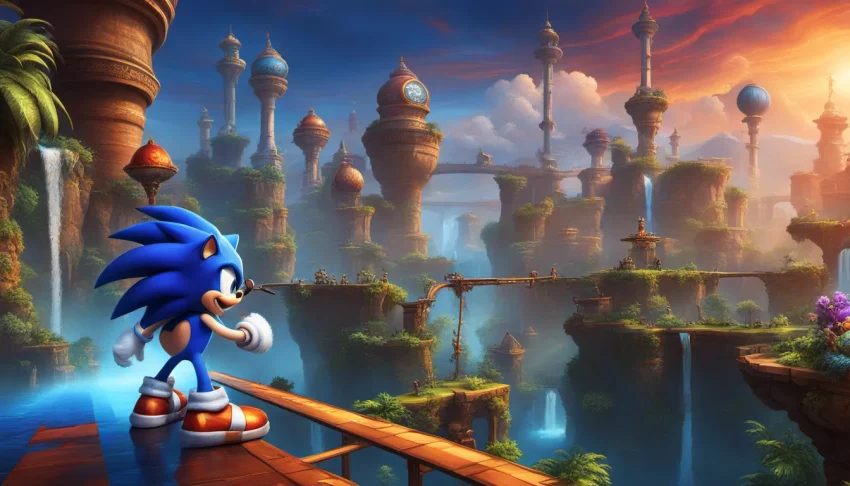Sonic CD is commemorating its 30th anniversary today, September 23, 2023. Below, we reflect on how its innovative concepts influenced the series moving forward.
Attempting to reach a consensus among Sonic enthusiasts regarding anything related to the franchise is already challenging, but soliciting their opinions on Sonic CD might yield more divided responses than any other game in the series. Among all the classic Sonic titles, CD stands out as a peculiar anomaly in terms of its game design, which elicits strong opinions from the fandom. However, the reasons behind its divergence from its cartridge-based counterparts are themselves intriguing. In many ways, Sonic CD feels like the inception of an alternative evolutionary path that the Sonic series could have taken in the future, but ultimately did not pursue.
Following the immense success of the first Sonic the Hedgehog game, Sega wasted no time in developing follow-up games. Two key members of Sonic’s development team, Yuji Naka and Hirokazu Yasuhara, joined forces with Mark Cerny, the future architect of the PlayStation console, at Sega Technical Institute in the United States. Meanwhile, other original Sonic Team members remained in Japan to plan a Sonic game for the emerging Mega-CD (known as Sega CD in the West) add-on. Although the system was struggling in its home market, it showed promise for success overseas, much like the Mega Drive (or Genesis). With Nintendo preparing to release its own CD system add-on, having a standout title like Sonic on the CD platform would be a significant advantage in the anticipated CD-ROM competition (which never materialized, but hindsight is always 20/20).
Initially, Sonic CD was conceived as an enhanced remake of the original game, similar to several other Mega-CD titles. However, this idea was swiftly abandoned. Sonic was a proven system-seller, and it was believed that an entirely new Sonic game that fully utilized the hardware would help drive sales of the more expensive Sega CD systems worldwide. (I personally desired a Sega CD the moment I learned that Sonic was coming!) In an era before online communication and cross-continental development through the internet was feasible, communication between the two Sonic development teams was limited, resulting in a sort of Galapagos effect: Gameplay concepts, visual identity, and technical expertise developed independently between the Japanese Sonic CD team and the US-based Sonic 2 team.
However, this is not to say that there was no interaction between the two teams. During the planning stages of both games, the teams did share their basic game concepts with each other. One of the key gameplay elements of Sonic CD, time travel, was initially planned for Sonic 2, as revealed by Hirokazu Yasuhara. It remains unclear whether the idea originated from the Japanese or US team, or if it was independently conceived by both teams, but it was ultimately abandoned for Sonic 2. Instead, Sonic CD would utilize the additional storage space provided by the CD-ROM to create multiple variations of each level in different time periods. Furthermore, the stages would be presented as if Sonic were progressing through a day, witnessing Dr. Eggman’s corrupting influence intensify in each level. Although this vision did not fully materialize due to the removal of a stage early in development, remnants of it can still be observed in the final game.
The time-travel concept became the cornerstone of Sonic CD’s design. Sonic would transition between time periods by building up sufficient speed, transporting him to the past and either good or bad futures. Level layouts and stage gimmicks would remain similar but differ across time periods. For instance, a hollow log found in the past would be partially decayed in the present and nearly nonexistent in the future. Robotic enemies that appeared freshly constructed in the past would be partially broken and worn-down in the far-future variations of the levels. Each time period would possess its own distinct visual design and soundtrack, with the interesting touch of the past stages utilizing hardware-generated sound instead of redbook audio, although this was not the original plan.
To facilitate the time-travel mechanic and create multiple variations of each stage, Sonic CD’s level design diverged significantly from what was being developed for Sonic 2. Sonic 2’s levels featured various speed-related gimmicks and were predominantly linear, offering multiple paths but limited flexibility once a path was chosen. In contrast, Sonic CD’s levels were more densely populated yet less restrictive. Players had the freedom to backtrack and thoroughly explore every nook and cranny of each stage in every time period. In fact, thorough exploration was often necessary to discover areas where Sonic could gather sufficient speed to initiate time warps, which presented a considerable challenge.
The stage gimmicks in Sonic CD also exuded an air of audacious experimentation. Many design elements found in this game are absent in any other classic Sonic title, with the exception of Sonic Mania, which still did not incorporate all of them. These include foreground/background shifting, bouncy brass-tubing tunnels, peculiar spinning pistons, thick walls composed of glass spheres that shatter with a satisfying break sound, and, of course, the infamous electrified floor in Wacky Workbench that propels Sonic straight up to the ceiling when touched at specific times. (Wacky Workbench, in particular, is often criticized as a subpar Sonic Zone, but I personally admire its sheer audacity—how many other platform games would dare to implement such a bizarre gimmick?) Each stage and time zone is brimming with unique quirks that encourage exploration as the ideal approach to gameplay. Sonic CD does not lack the exhilarating speed and momentum characteristic of other Sonic games, but it is unafraid to slow down the pace and encourage players to thoroughly explore—an aspect that some Sonic fans find contradictory to their enjoyment of the games.
Taking the time to meticulously navigate through the levels not only unveils numerous delightful secrets and playful gimmicks, but also allows players to appreciate the stunning visuals. The Mega CD was a powerful add-on, but it could not compensate for one of the limitations of the original Genesis/Mega Drive hardware: the restricted number of on-screen colors. Many games on the system are notorious for appearing grainy and washed-out compared to contemporaneous SNES titles. However, when observing various stages in Sonic CD, one would be oblivious to the fact that there was a strict limit of 64 colors on display. (Of course, the bad future stages intentionally possessed a grimy, dull-colored aesthetic, effectively conveying a sense of despair and misery.) The art direction by Hiroyuki Kawaguchi and art design by Kazuyuki Hoshino seamlessly integrated with Sega of Japan’s early-’90s aesthetic of vibrant, high-tech geometry and computer graphics.
While Sonic 2 was released in late 1992, the Sonic CD team was preparing the initial build of the game to showcase at an event called Yuusei Sega World. The final game would be released in the summer of 1993 in Japan, but not before undergoing numerous revisions, with minor changes occurring until the last minute. As is customary in game development, ideas were scaled back and modified. The special stage transitioned from an expanded rotating arena akin to Sonic 1 to a balloon-popping challenge and eventually evolved into chasing UFOs (which underwent multiple shape changes). The soundtracks for the past stages abandoned the use of redbook audio. The time-travel interstitial screen underwent multiple visual and audio effects. However, perhaps the most significant omission is the stage known as R2. When navigating the game’s stage select, the zone numbers jump from 1 to 3, indicating that stage 2 was removed at some point. Images of enigmatic underground ruins from the game’s development phase have captivated fans for years. Despite numerous re-releases featuring development-related extras, there remains surprisingly little information about what was originally planned. Over the years, fans have actively sought out and preserved numerous development builds of Sonic CD, providing a fascinating glimpse into the game’s evolution.
There is an abundance of topics worth discussing regarding Sonic CD—the introduction of Amy Rose and Metal Sonic, the controversy surrounding the replacement of music in the North American release, the various reissues. However, it is the game’s distinctive design, unlike any other Sonic title of its era, that has rendered it most memorable. Although it did not achieve the desired sales figures for the Mega-CD, its aesthetic design has become synonymous with classic Sonic and continues to be a subject of extensive discussion among fans. With Sonic Superstars reintroducing the director of Sonic CD in a design role and some original Sonic CD staff still employed at Sega, I am eagerly anticipating the extent to which Sonic CD’s influence will be evident in Superstars. Perhaps we will witness the return of those Wacky Workbench floors… I cannot be the only person who would relish that, can I?

